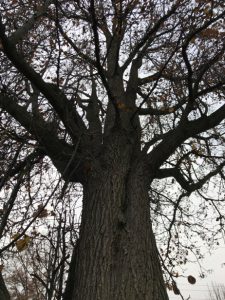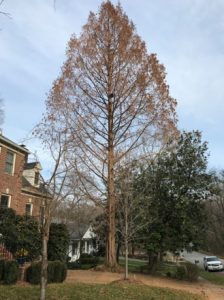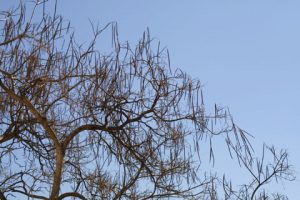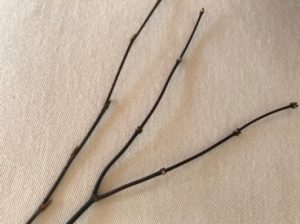Trees in Winter
Survival, Structure and Symmetry
By Gretchen Spencer, Fairfax Master Gardener

Winter tree architectural silhouette
Winter poses its own challenges for deciduous trees, such as the cold and lack of water (although here in the Washington D.C. area, we’ve been inundated with rain!). However, trees have several marvelous and complex adaptations that allow them to survive in harsh conditions.

Bold trunk and spreading branches of a linden tree
First, as everyone knows, trees drop their leaves in the fall to prevent water loss and winter injury, spurred on by the photoperiod, or reduction of daylight. The gradual loss of daylight allows time for the trees to adapt to the coming cold. When the leaves fall, a special layer of cells called the abscission layer grows at the base of each leaf stem to protect it. However, some trees retain their dead brown or tan leaves well into winter or until new growth pushes them off in the spring. This condition, called marcescence, is not well understood. I have noticed this on young beech trees and some varieties of oaks. Some theories are that maintaining the leaves prevents animals from browsing on them, protects leaf buds from drying out or desiccation or provides a nutrient layer for the tree when they drop in the spring.
Second, trees have to prevent the formation of ice crystals in their cells. To do this, the water in the cells moves into the spaces between the cells where freezing will not harm the tree. The remaining content in the cells thickens to help prevent ice crystals from forming.

American sycamore
It’s amazing to realize that all these adaptations have taken place in the bare and stark trees that now fill the landscape. Close observation of trees in winter not only reveals their beauty, variety, structure and symmetry, but provides important clues to their identification.
In the evening, just at dusk, is my favorite time to look up at the trees. Their silhouettes against a bluish-gray sky show off their individual shapes, many of which are symmetrical, and the boldness of their trunks and the delicate webbing of their branches and twigs. This linden or basswood tree (Tilia Americana) is a good example.

Winter symmetry of dawn redwood
The wonderful symmetry of the dawn redwood (Metasequoia gylptostroboides) is particularly obvious after dropping most of its leaves. A deciduous conifer, similar in appearance to the native Bald cypress (Taxodium distichum), the dawn redwood has opposite leaves and branches as is evident in this photo.

Catalpa pods
In the winter is a good time to examine the twigs of trees as they give clear clues to their identity. Most important is determining whether a tree has opposite or alternate branch and bud arrangement. There are only a handful of trees that have opposite branching, and they can be remembered by the acronym M.A.D. Horse Bucks. They are the maples, ashes, dogwoods, horse chestnuts and buckeyes. Once you can tell whether a tree is opposite or alternate, narrows the process of identifying it.

Alternate (left) and opposite (right) bud structure
I hope this article may have inspired you to look more closely at the winter trees in your neighborhood and to notice their wonderful symmetry and structure while marveling at their architectural presence in the winter landscape.
Resources
• Survival Adaptations: How Trees Cope with Winter, Michael Gambino, Curator, Friends of Read
Wildlife Sanctuary
• How do trees survive in the winter?, Bill Cook, Michigan State University, Extension
• Biozine, Houghton Mifflin Harcourt
• When Leaves Don’t Leave, Jon Hetman, the Blog of the Arnold Arboretum
• Winter Tree Finder: A Manual for Identifying Deciduous Trees in Winter, by May Theilgaard Watts and
Tom Watts